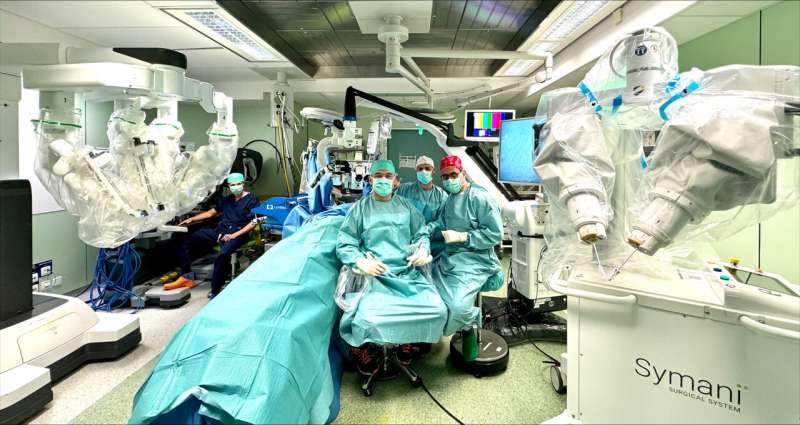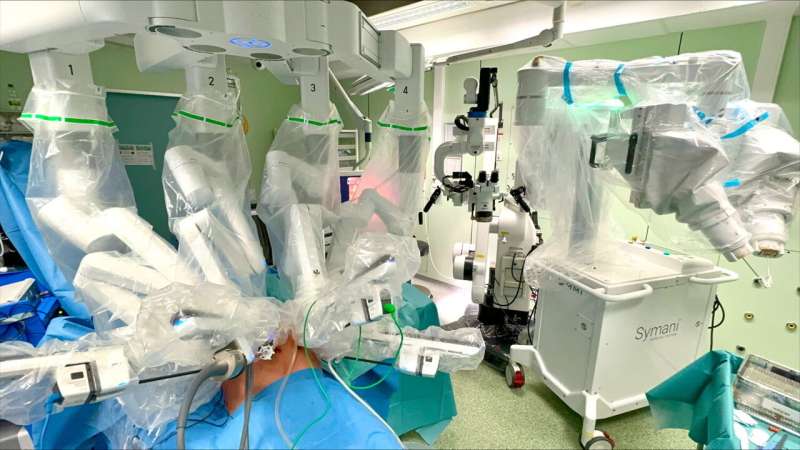
UZ Brussel is the first hospital worldwide to perform dual-robot assisted lymphedema surgery. The main advantage of this approach is that it is much less invasive for the patient, resulting in less pain and less time spent in hospital. Moreover, robot-assisted surgery is significantly more accurate than conventional surgery.
In so doing, UZ Brussel is building on its expertise in robot-assisted surgical lymphedema treatment after Professor Moustapha Hamdi performed the first-ever robot-assisted lymph node transplant in Europe in 2018.
During the surgery on Wednesday, April 17, the Da Vinci Xi surgical system was combined with MMI’s Symani surgical system. In collaboration with abdominal surgeon Dr. Martijn Schoneveld, the plastic and reconstructive surgery team performed a fully robotic lymph node transplant, overseen by Professor Hamdi, Head of Department of Plastic Surgery at UZ Brussel.
Dr. Schoneveld, abdominal surgeon, explained, “First, we use the Da Vinci Xi to remove a part of the peritoneal fold at the level of the stomach in a patient suffering from lymphedema after breast cancer surgery. With the robot, we can harvest the necessary tissue from the stomach with tools that offer more dexterity and finer motor control, leaving little scarring.
“The magnified 3D image on the console helps us carry out this surgical procedure which requires a great deal of precision, ensuring minimal damage to blood vessels and lymph node tissue before reimplantation in the armpit, which is important for the successful outcome of the surgery.”
Professor Hamdi, Head of Department of Plastic Surgery at UZ Brussel, continued, “Afterwards, the plastic surgeon transplanted this flap to the armpit using MMI’s Symani surgical system. This procedure facilitates lymphatic drainage from the upper limb. The aim is also to prevent future swelling of the arm and thus reduce the swelling and pain caused by lymphedema.”
Professor Alexandru Nistor, plastic surgeon, added, “The microsurgery robot is used for super microsurgery and other complex plastic and reconstructive procedures, e.g., connecting the finest anatomical structures together, such as blood vessels or lymphatic vessels. Lymphatic vessels have a diameter of less than 0.8 millimeters.
“We use this advanced technology on patients with lymphedema and/or breast cancer, among others. The Symani robotic surgical system allows us to achieve the greatest possible precision when connecting two small delicate vessels during microsurgery, ensuring the best possible transplant success rate. The risk is minimal for the patient, guaranteeing the best results.”

New step in robot-assisted lymphedema treatment
In 2018, UZ Brussel was the first European hospital to perform a robotic-assisted lymph node transplantation. A multidisciplinary team, led by Professor Hamdi and abdominal surgeon Dr. Van Eetvelde, removed lymph nodes from the abdomen for transplantation to the armpit.
Last year, the team took another step forward, with the introduction of a robot for micro- and super microsurgery, also for lymphedema treatment, for a bridge between the lymphatic vessel and the vein. These types of interventions, on the very smallest blood vessels in the body, require extreme precision. MMI’s Symani surgical system can scale down the surgeon’s hand movements 20x, filtering out even minimal vibrations from the surgeon’s hand.
This game changer means surgeons can now perform complex procedures with even greater precision, resulting in less risk of tissue damage and a faster recovery for patients.
Lymphedema is swelling in an arm or leg. It can be congenital or occur because of cancer treatment, radiation, or infection. Lymphedema remains a significant quality of life issue.
The swelling is caused by an accumulation of lymph fluid in the connective tissue. Usually, this fluid is drained through the body’s lymphatic vessels and glands, but if this process is disrupted by malfunctioning lymphatic vessels or removal of lymph nodes, fluid can build in the body’s tissues. Up to 30% of breast cancer patients have lymphedema, which can cause severe functional impairments.
Provided by
Vrije Universiteit Brussel
Citation:
Surgeons perform first-ever dual robotic surgery on patient with lymphedema after breast surgery (2024, May 2)
surgeons-dual-robotic-surgery-patient.html
.
. The content is provided for information purposes only.
